The use of polyethylene glycol as a maintenance treatment of functional constipation in children living in Egypt
IF 0.5
Q4 PEDIATRICS
引用次数: 0
Abstract
Constipation is an underestimated but common health problem worldwide, decreasing the quality of life. Functional constipation (FC) is a common pediatric problem, with reported prevalence ranging from 0.7 to 29.6%. In Egypt, there are no established guidelines for the treatment of constipation in children. The aim of this study was to investigate the efficacy of polyethylene glycol (PEG) as a maintenance treatment for functional constipation (FC) in comparison with the classic treatment using (lactulose and senna) in children living in Egypt. This is a randomized single-blinded clinical trial study on pediatric patients who presented with functional constipation at the outpatient clinic of Cairo University Specialized Pediatric Hospital. The study was conducted on 80 children with functional constipation, who were divided into 2 groups: group 1 (40 children), who received polyethylene glycol as maintenance treatment; group 2 (40 children), who received classic treatment in the form of osmotic laxative (lactulose) with or without stimulant (senna-sennosides or senna-glycoside) according to the stool consistency. Our data showed significant improvement in the fecal masses and the number of defecation, fecal pseudo incontinence, painful or hard bowel movement, history of retentive posturing or excessive violation, and large fecal masses in the rectum between group 1 and group 2 after treatment. In group 1, there was a significant improvement in anthropometric measures, CBC parameters, abdominal circumference, and anal fissures and piles after treatment; also, there was a significant decrease in the number of patients that need to continue treatment in group 1 in comparison with group 2 and number of patients that had impaction during treatment. However, there was a statistically significant increase in the number of patients who complained of palatability in group 1. PEG has long-term efficacy in the management of pediatric functional constipation. Significant improvement of results in comparison with the classic treatment (lactulose or senna-lax).使用聚乙二醇维持治疗埃及儿童的功能性便秘
便秘是一种被低估但在世界范围内普遍存在的健康问题,它会降低生活质量。功能性便秘(FC)是一种常见的儿科问题,据报道患病率从0.7%到29.6%不等。在埃及,没有治疗儿童便秘的既定指南。本研究的目的是研究聚乙二醇(PEG)作为功能性便秘(FC)的维持治疗与经典治疗(乳果糖和番泻叶)在埃及儿童中的疗效。这是一项随机单盲临床试验研究,针对在开罗大学儿科专科医院门诊出现功能性便秘的儿科患者。本研究将80例功能性便秘患儿分为2组:1组(40例),采用聚乙二醇维持治疗;第二组(40例),根据大便粘稠度给予经典的渗透性泻药(乳果糖)加或不加兴奋剂(番泻子皂苷或番泻子糖苷)治疗。我们的数据显示,治疗后1组和2组在大便团块和排便次数、大便假性失禁、排便疼痛或硬肠、保留姿势或过度违逆史、直肠大大便团块等方面均有显著改善。治疗后,1组患者的人体测量、CBC参数、腹围、肛裂和肛管均有显著改善;此外,与2组相比,1组需要继续治疗的患者数量和治疗期间发生嵌塞的患者数量也显著减少。然而,在第一组中,抱怨口味不佳的患者数量有统计学上的显著增加。聚乙二醇治疗小儿功能性便秘具有长期疗效。与经典疗法(乳果糖或番泻草素)相比,效果显著改善。
本文章由计算机程序翻译,如有差异,请以英文原文为准。
求助全文
约1分钟内获得全文
求助全文
来源期刊

Egyptian Pediatric Association Gazette
PEDIATRICS-
自引率
0.00%
发文量
32
审稿时长
9 weeks
期刊介绍:
The Gazette is the official journal of the Egyptian Pediatric Association. The main purpose of the Gazette is to provide a place for the publication of high-quality papers documenting recent advances and new developments in both pediatrics and pediatric surgery in clinical and experimental settings. An equally important purpose of the Gazette is to publish local and regional issues related to children and child care. The Gazette welcomes original papers, review articles, case reports and short communications as well as short technical reports. Papers submitted to the Gazette are peer-reviewed by a large review board. The Gazette also offers CME quizzes, credits for which can be claimed from either the EPA website or the EPA headquarters. Fields of interest: all aspects of pediatrics, pediatric surgery, child health and child care. The Gazette complies with the Uniform Requirements for Manuscripts submitted to biomedical journals as recommended by the International Committee of Medical Journal Editors (ICMJE).
 求助内容:
求助内容: 应助结果提醒方式:
应助结果提醒方式:


